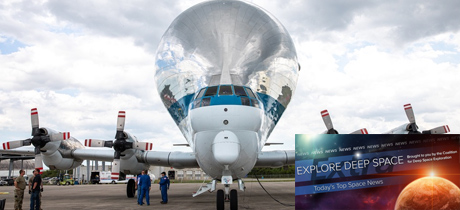In Today’s Deep Space Extra… Despite coronavirus pandemic constraints, NASA’s Artemis 1 Orion crew capsule returns to NASA’s Kennedy Space Center (KSC), following crucial pre-launch testing in Ohio.
Human Space Exploration
NASA looking to play greater role in coronavirus pandemic response
Coalition Member in the News – Northrop Grumman
SpaceNews.com (3/25): The Orion capsule assigned to Artemis 1, NASA’s first joint test launch of a Space Launch System (SLS) rocket and the future crew capsule, was flown from the Glenn Research Center in Ohio to the Kennedy Space Center (KSC) in Florida on Wednesday, after lengthy thermal vacuum testing. Meanwhile, NASA is reaching out with other federal agencies to respond to the coronavirus threat, though nine of 18 facilities are now closed to all workers but those assigned to safety and security activities.
NASA looking to “vector” its expertise to fight covid-19, gets $60 million in Senate stimulus bill
Spacepolicyonline.com (3/26): NASA joins fight against coronavirus pandemic. A stimulus bill passed by the U.S. Senate late Wednesday includes $60 million for the agency’s assistance.
Space Science
This powerful ion engine will be flying on NASA’s DART mission to try and redirect an asteroid
Universe Today (3/25): A critical asteroid deflection test mission, DART, planned by NASA will rely on a xenon fueled ion drive propulsion system to demonstrate a defense against a threat to humanity potentially more devastating than the coronavirus pandemic. A July 2021 launch is planned.
Welcome to the future: 11 ideas that went from science fiction to reality
Space.com (3/25): Creative inventions from such famous science fiction venues as Star Trek are now finding a place in modern technology.
Behold the “quasar tsunami,” which can kill an entire galaxy
Futurism (3/25): Scientists using the Hubble Space Telescope describe an unprecedented high temperature cosmic force, a “quasar tsumami” spawned by a supermassive black hole.
Revisiting decades-old Voyager 2 data, scientists find one more secret
NASA/Jet Propulsion Laboratory (3/25): Launched to the solar system’s outer planets in 1977, NASA’s Voyager 2 sped by Uranus in 1986. A new look at the data from the spacecraft has revealed a surprise, a giant magnetic bubble was pulling the large planet’s atmosphere out into space.
Op Eds
Commentary | Space and coronavirus, any connection?
SpaceNews.com (3/25): In an op-ed, Jan Woener, director general of the European Space Agency (ESA), declares the growing coronavirus concern a call for greater global cooperation.
Other News
Prototype thrusters designed for use on the Moon undergo key hot-fire testing
Coalition Members in the News – Astrobotic, United Launch Alliance
Tech Crunch (3/25): New attitude control thrusters developed by NASA and Frontier Aerospace show promise for potential use aboard Astrobotic’s commercial Peregrine Lunar Lander, which is planned for an initial lunar mission launch on a Vulcan Centaur rocket in July 2021.
Military officials committed to keeping Cape Canaveral open for launches
Coalition Member in the News – United Launch Alliance
Spaceflightnow.com (3/24): Despite the coronavirus outbreak, the U.S. Eastern Range is committed to supporting planned launches from Florida’s Space Coast in the coming weeks. A United Launch Alliance (ULA) Atlas 5 with a U.S. Space Force communications satellites is planned to liftoff today (March 26) from Cape Canaveral Air Force Station, Florida, at 2:57 p.m., EDT, the opening of a two hour launch window.
The coronavirus is starting to have a serious impact on the space industry
Coalition Member in the News – United Launch Alliance
Forbes.com (3/25): A global aerospace community response to the covid-19 concern includes uncertainty over a possible late spring SpaceX crewed test flight of the Dragon 2 to the International Space Station (ISS), the July launch of NASA’s Mars 2020 rover and preparations for a March 2021 launch of the James Webb Space Telescope (JWST).
What it looks like from space when everything stops
Bloomberg.com (3/24): Planet Lab satellites offer before and after images of the impacts the coronavirus pandemic and recession are having on familiar locations around the world.

